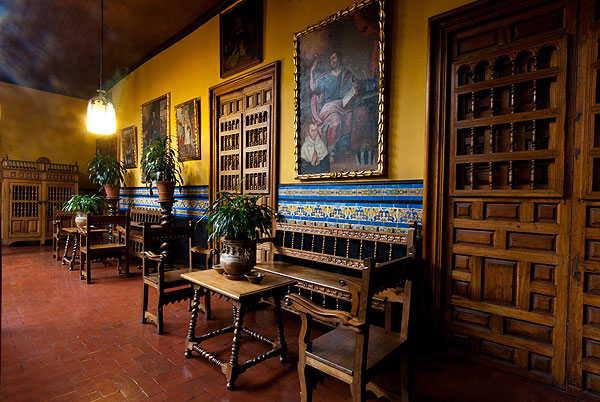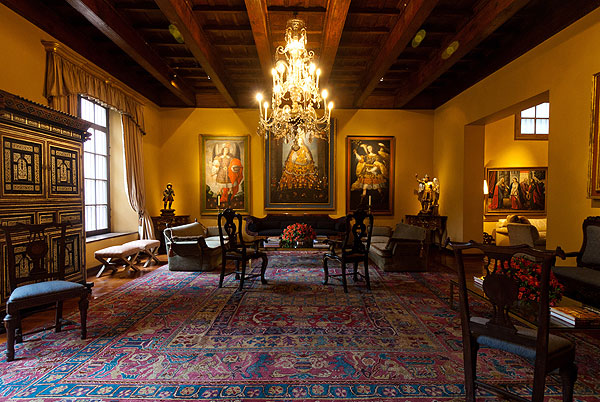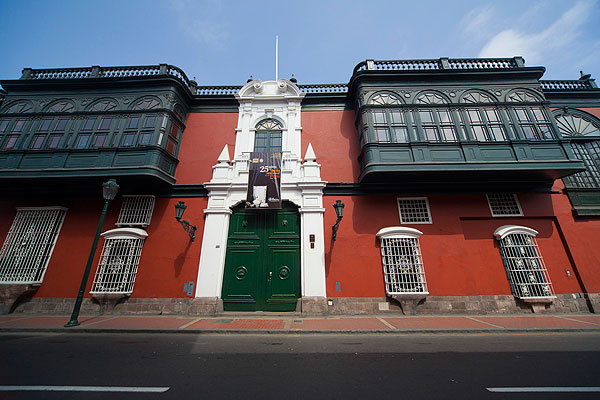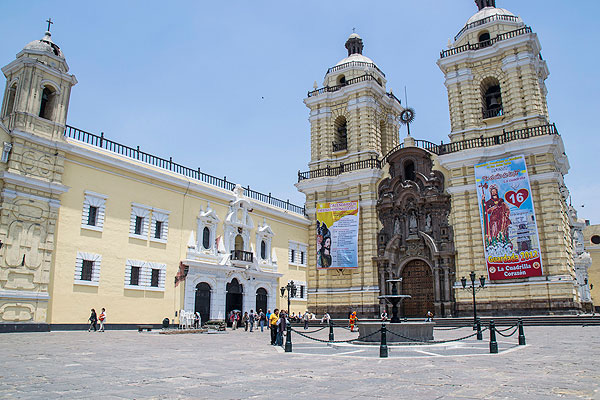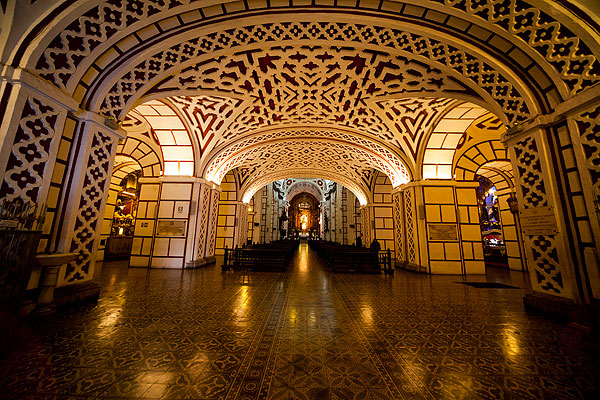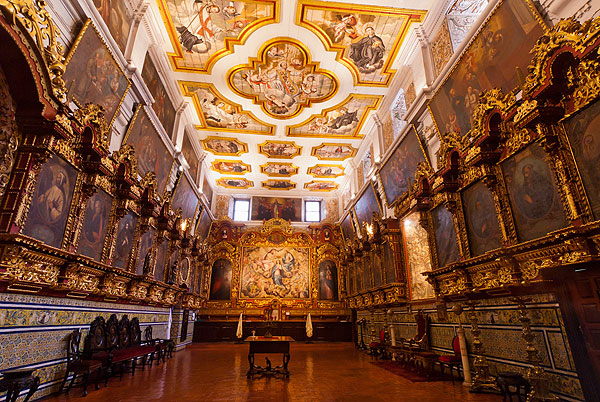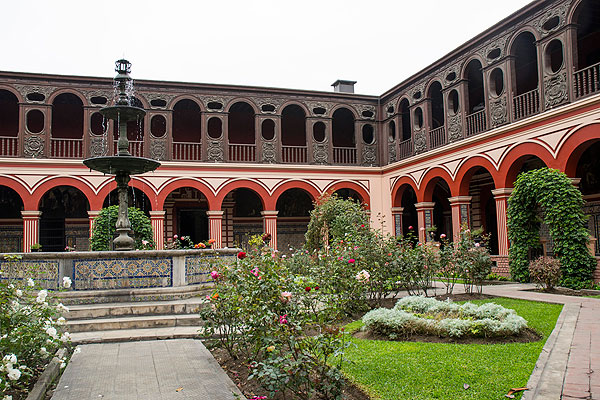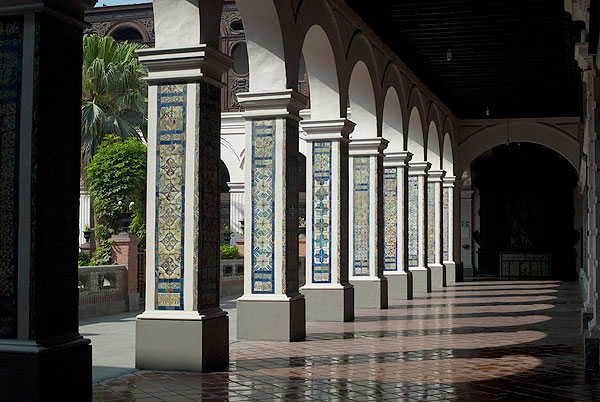Historical Centre of Lima City
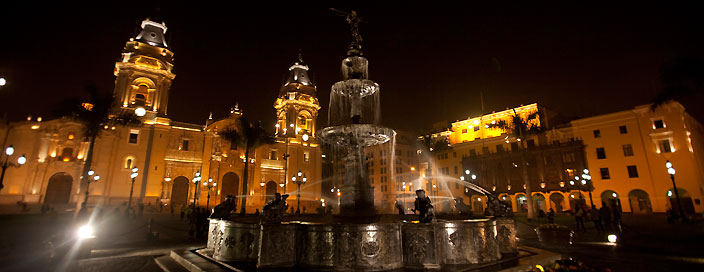
Lima also called "Ciudad de los Reyes" (City of Kings), is located in the Rimac valley and was founded in 1535 by Spanish conqueror Francisco Pizarro, was the seat of the Viceroy and the main administrative center of the Spanish colony in South America, the capital of Nueva Castilla.
From the beginning Lima, the city of kings and viceroys, was an oasis of culture and elegance in the American Indies. Just a few decades after its foundation, Lima already rivaled Mexico as the most important metropolis in the Spanish-American empire. Baroque and Renaissance churches, mansions, palaces, universities and archdioceses filled Lima. The cultural scene positively hummed as early as the beginning of the seventeenth century, when Lima had but a population of just 25.000.
The walled part of the colonial city today is known as "Damero de Pizarro", where centuries-old churches, highlighting San Francisco and Santo Domingo, convents, monasteries and magnificent colonial mansions with elegant balconies have been preserved, representing renaissance, baroque, neoclassical, and other contemporary styles. (Map of Historical Centre)
Sights and Attractions in Lima's Colonial Heart
World Heritage Site
The arrival of modernity didn't transform the historic center, which is recognized as a Cultural World Heritage Site by UNESCO in 1988.
Although severely damaged by earthquakes, this 'City of the Kings' was, until the middle of the 18th century, the capital and most important city of the Spanish dominions in South America. Many of its buildings, such as the Convent of San Francisco (the largest of its type in this part of the world), are the result of collaboration between local craftspeople and others from the Old World.
The authenticity of the Historic Centre of Lima is intact as it largely preserves the original features of its urban foundation design, as a checkerboard, and the expansion area from the XVI to the XIX century, including old pre-Hispanic paths heading North (Chinchaysuyo) and East (Antisuyo). Public, private and religious buildings generally preserve their architectural, technological, typological, aesthetic, historic and urban values, which are a result of the implantation of European styles from different stages of the city’s historic evolution process from the XVI to the XX century. (UNESCO).
Plaza Mayor (Main Square)
The site of the Spanish founding of Lima by Francisco Pizarro, the Plaza Mayor, has witnessed some of the most important historic events in Peru. The Plaza Mayor, or main square, was originally surrounded by small shops and businesses. It was also used as a bullring and scaffold to execute those condemned by the Holy Inquisition. More than a century later, a bronze fountain, built in the center in 1651, still stands today. It was in this plaza that Peruvians declared their independence in 1821. The Presidential Palace sits on the northern side of the square, while the Cathedral and Archbishop’s Palace are on the east side and the City Hall is located to the west.
Government Palace
Residence of Francisco Pizarro (1535), who built it on the ground previously occupied by Taulichusco, chief of the Rímac valley. Since then, the site has been the centre of political power in Peru. The building was rebuilt in the 1920s after a fire. It has many courtyards and halls dedicated to important figures in Peruvian history which have been carefully decorated with outstanding works of art. Daily, at 11:45, the Patio de Honor (Honour Courtyard) is the setting for the changing of the guard under the responsibility of the glorious Battalion of the Hussars of Junín.
Torre Tagle Palace
A two-storey building whose construction began in 1735 under the orders of the Marquis of Torre Tagle, treasurer of the Royal Spanish Armada. Considered to be one of the best examples of residential Lima architecture from the 18th century. Its carved wood balconies, the oratory in the Baroque style adorned with mirrors and colonial paintings and the entrance carefully carved in stone are interesting to see. It is currently the headquarters of the Foreign Affairs Office. Visiting Hours: Prior arrangement with the Ministerio de Relaciones Exteriores (Foreign Affairs Office). Location: Jirón Ucayali N° 323.
Casa Aliaga
Built with clay and adobe on the foundations of a pre-Hispanic building, its spaces had to be adapted due to an irregular layout over different levels. The main façade has a balcony built in the Republic era. Its courtyards are a highlight, the first decked in Italian marble from the 19th century and the second adorned with an old bronze fountain. The house has belonged to the same family from its construction in 1535 to the present day. Visiting Hours: Mon - Sun 9:30 am - 5:00 pm. Visits organized by travel agencies, or visitors can organise their own visits in advance. Location: Jirón de la Unión N° 224.
Casa de Pilatos
Built in the XVI century, of simple front, and its portal is a beautiful craft in stone. It possesses two balconies, one in corner and in its interior a monumental stairway. Mournful stories about its owners are known. At the moment it is the headquarters of the National Institute of Culture. Location: Jirón Ancash N° 390.
Casa de la Riva Agüero
Beautiful colonial mansion, great elegant porch and windows built in the XVIII century. In its exteriors beautiful carved wood balconies. Their living rooms conserve many of the original elements; the second patio has a captivating romantic atmosphere. The house was donated to Lima's Catholic University by the last of the original owners' descendants, Don José de la Riva Agüero. Today it houses the Riva Agüero Institute, which in turn features vast historic archives and a fine library. It is also the site of the Museo de Arte Popular, the Folk Art Museum. Location: Jirón Ica N° 426.
Casa Oquendo or Palacio de Osambela
The construction was finished in 1807 conserves the architectural style of the Lima of the XVIII century. Outstanding its five important external balconies, and the observatory in the superior part in which its first owner Martin de Osambela used to see the arrival of the galleons in the port of Callao. Location: Conde de Superunda N° 298.
Barrios Altos and Chinatown
One of the most traditional quarters of downtown Lima, this district was home to composers, intellectuals, musicians and Bohemian types, who took criollismo to new heights. Here one still finds some of the best examples of colonial and republican architecture that includes the Quinta Heeren, an area with its own plaza; the Casa de Trece Monedas, a majestic nineteenth-century residence; the Iglesia de las Trinitarias and the Molino de Santa Clara. Lima’s Chinatown, bordering the Mercado Central, is one of the largest in South America. Walking through its streets means getting to know the customs and products of this millennial culture. Mainly, it is about eating the delicious food found in the numerous area restaurants called "chifas". The Entrance Monument to Calle Capón is a nice architectural piece. Location: Jirón Paruro, Barrios Altos.
Parque de la Muralla (Park of the Wall)
Home to a restored fragment of the ancient wall that encircled Lima and which is believed to have been built in the 17th century to protect the city from pirates and attacks by enemies of the Spanish crown. The site contains the statue of the founder of Lima, Spanish conquistador Francisco Pizarro, as well as a museum exhibiting archaeological items discovered in the area. Visiting Hours: Mon - Sun 8:00 am - 10:00 pm. Free admission. Location: Jirón Amazonas block 1.
Magic Circuit of the Water - Parque de la Reserva
The Magical Water Tour is a peaceful space where water, light and music exist in perfect harmony, presenting an unforgettable spectacle. 13 cybernetic, ornamental and interactive fountains have been installed, which use state-of-the-art technology and are activated when the sun goes down. The fountains shoot jets of water up to 80 metres high. Visiting Hours: Water fountains shows: Wed - Sun and public holidays 3:00 pm - 10:30 pm. Fuentes de las Fantasías (Magical Water Fountains) Shows 7:15 pm, 8:15 pm and 9:30 pm. Free admission: Mon - Sun and public holidays 6.00 am - 1.00 pm. Location: Avenida Arequipa block 6.
Matías Maestro General Presbyterian Cemetery
The first graveyard in the City of Lima. Inaugurated in 1808 by Viceroy Abascal, the architect was the Spanish master builder, the Presbyterian Matías Maestro. The site holds over 766 mausoleums in the neoclassical style. Highlights include statues and sculptures inspired by saints and theological virtues and the Panteón de los Próceres (Pantheon of Heroes). Visiting Hours: Mon - Fri 8:00 am - 6:00 pm. Guided night visits are available on the last Thursday of every month (except December), arrangement in advance required. The trip lasts 2 hours 30 minutes. Location: Jirón Ancash blocks 16-20.
Religious Monuments of Lima's Historical Centre
Cathedral - Museum of Religious Art
Located in front Plaza Mayor, next to Archbishop's Palace, it occupies the site where the first major church in Lima once stood. It has an austere interior, although it is home to genuine historical treasures including the Baltasar Noguera choir stalls, several side altars and the remains of Francisco Pizarro. Tourists can also visit the Museum of Religious Art, which holds a significant collection of paintings, sculptures, chalices and chasubles. Visiting Hours: Mon - Fri 9:00 am - 5:00 pm / Sat 10:00 am - 1:00 pm.
San Francisco Church and Convent
Most important religious monument of Lima. Consecrated in 1,673, built in 1,542 in Baroque style, of great aesthetic beauty. It includes the church, convent and plaza. The main façade of the temple was built using stone and features Corinthian columns. The façade boasts an open cornice with arches in which the Immaculate Conception is depicted. The cloisters area, decorated with tiles, houses the Museum of Vice-Royalty Art. The catacombs (subterranean galleries), which served as a cemetery during the colonial era, can also be visited. Visiting Hours: Mon - Sun 9:30 am - 5:30 pm. Church: 7:00 am - 11:00 pm and 4:00 pm - 8:00 pm. Location: Jirón Ancash block 3.
San Pedro Church
Built in 1636, the church was inspired by the Jesuit mother church in Rome, with three naves. Unique in Lima due to its three entrances, a characteristic that is unique to cathedrals. It stands out due to its Churrigueresque altarpieces, and the space in the central naves feels full of paintings and tiles. Among the works of art that are stored here, paintings from the Lima, Cusco and Quito schools are highlights, as are a series of golden carvings of some the founders of religious orders and a painting depicting the coronation of the Virgin by painter Bernardo Bitti. Visiting Hours: Mon - Sun 6:30 am - 12:30 pm and 5:00 pm - 8:00 pm. Free Admission. Location: Jirón Ucayali N° 451.
Santo Domingo Church and Convent
A church with three naves, in which the dome and a finely carved cedar choir stall are most impressive. The convent walls are decorated with Seville tiles and its chapter house features Baroque carvings. In 1551, the Universidad Nacional Mayor de San Marcos was founded in the convent, the first university that the Spanish crown created in the Americas. Visiting Hours: Mon - Sun 9:30 am - 6:30 pm. Location Jirón Camaná N° 170.
La Merced Church and Convent
Built in the eighteenth century, this church is an excellent example of the splendor of Spanish colonial architecture. With a Churriguerra façade, the church is filled with works of art, such as the main altar dedicated to the Virgen de las Mercedes, patron saint of the Peruvian armed forces, and a beautiful sacristy decorated with Arabesque tiles. La Merced houses one of the finest collections of colonial oil paintings and carvings in Lima. Visiting hours: Mon. – Sun. 8:00 am.- 12:00 pm. and 4:00 pm.- 8:00 pm. Location: Jirón De la Unión N° 621.
San Agustín Church and Convent
Built in 1574, of Churrigueresque portal entirely carved in stone, sacristy with beautiful wooden images, in the sacristy beautiful decorations made of wood, a baseboard of tiles and an important carving of "La Muerte" (The Death), masterpiece by the Peruvian master Baltazar Gavilán (XVIII Century). Location: Intersection of Jirón Ica and Jirón Camaná.
Las Nazarenas Church
Built in the second half of the 18th century in the lands formerly belonging to the colonial Pachacamilla neighborhood. The central part of the altar is formed by two ridged and gold-covered Tuscan pilasters, which support a Baroque façade. Inside the church, in the form of an urn, the image of Señor de los Milagros (Our Lord of Miracles) can be found, painted in oil on a rough adobe wall. According to tradition, this image of Christ was painted by an African slave in the 17th century, and this was the only wall that remained standing after earthquakes in 1655, 1687 and 1746. Each October, there is a huge procession with a replica of the image, also known as the Purple Christ, through the streets of Lima. Visiting Hours: Mon - Sun 6.00 am - 1.00 pm and 4.00 pm - 9.30 pm. Location: Intersection of Jirón Huancavelica and Avenida Tacna.
Santa Rosa Church and Sanctuary
Built on the place in which Isabel Flores de Oliva was born (1568-1617), Santa Rosa de Lima was canonized by the Pope Clemente X in 1671, called the Landlady of Lima, America, Philippines and Oriental India. In the garden is conserved the hermitage that Santa Rosa built with the help of her brother and the well where she threw the key of the chain that stuck to her waist in sign of penance. All the devoted parishioners who visit this well, write their wishes on a piece of paper and then throw them to the well attributing miraculous character. Visiting hours: Mon. - Sun. 9:00 am. - 1:00 pm. and 3:00 pm. - 6:00 pm. Location: Avenida Tacna, block 1.






